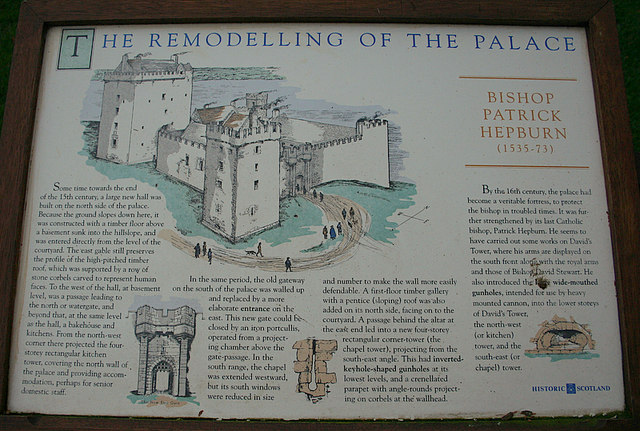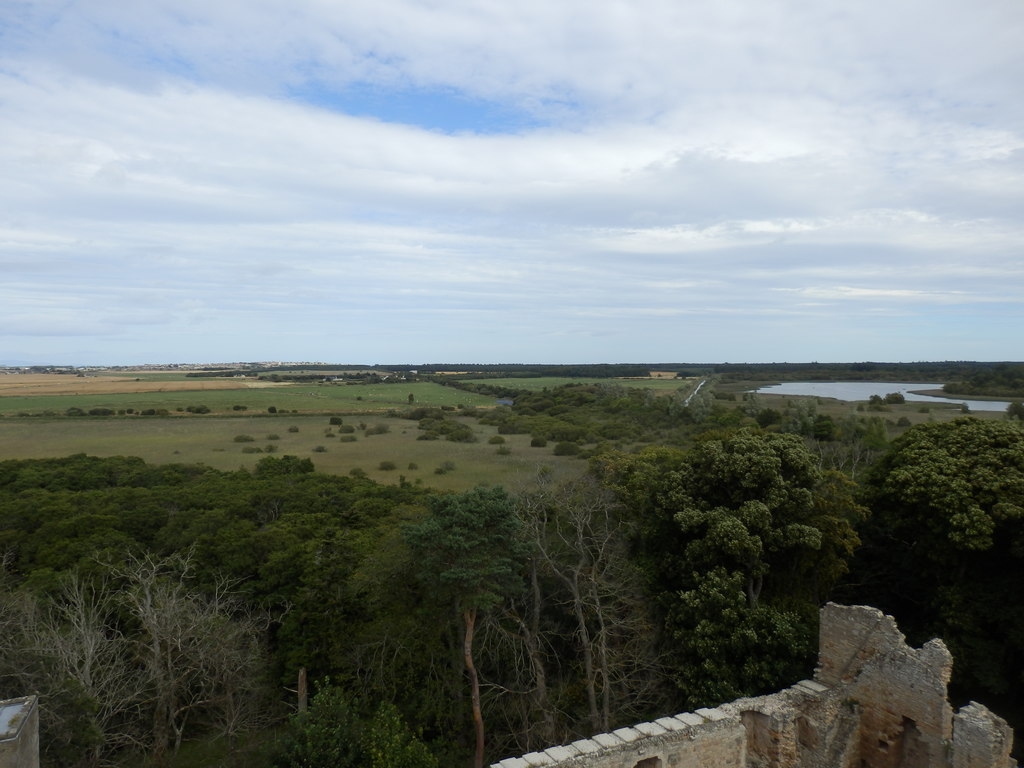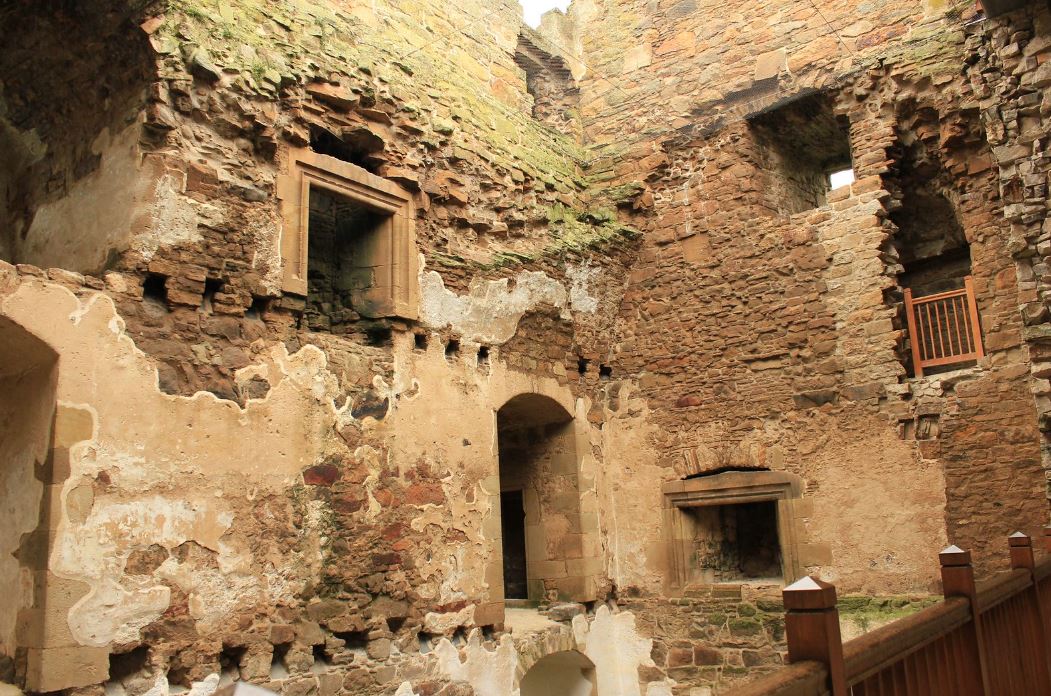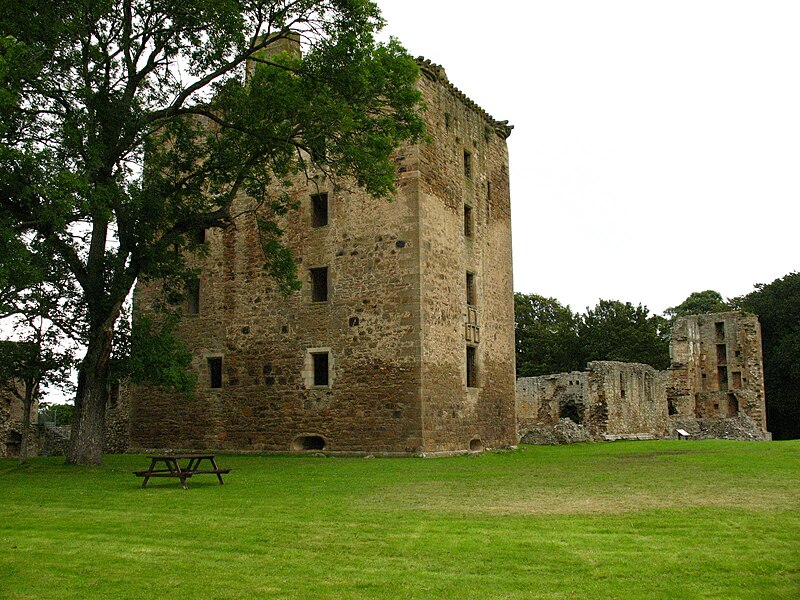Up for an adventure in the ruins of a bishop’s house north of Elgin?
Spynie Palace, once the magnificent residence of the bishops of Moray, now stands as a testament to five centuries’ worth of fascinating Scottish history. Exploring the depths of Spynie Castle and listening to its secrets as you wander through the forgotten halls is one of the best things to do in Elgin.
Listen to the tales of strength and willpower in this old palace and stroll around the beautiful ruins of the courtyard. If you love being in the middle of the action, take the journey up to David’s Tower, where the bishops of Moray used to dine with royalty.
From the ground floor filled with stunning large windows and stone seats to the glorious spiral staircase; Spynie Palace, Elgin, Scotland, is a sight to behold!
History of Spynie Palace
The history of Spynie Palace, Elgin, Moray dates back all the way to the 12th century! The mighty bishops of Moray made Spynie Palace their home in the late 1100s, but this historic Scotland site told hundreds of stories over many centuries.
Spynie Palace was a cathedral around 1207, but Bishop Andrew later built Elgin Cathedral to replace it as a chapel residence for the bishops of Moray. Spynie Palace remained a bishop’s house on the shore of a sea loch for a long time.
In 1390, the Earl of Buchan, Alexander Stewart (the Wolf of Badenoch), set Elgin Cathedral alight. A few years after Alexander died, the King took over the castle and appointed a new bishop.
In the 1400s, John de Winchester (one of the bishops of Moray) moved the main gate over to the east side of the residence.
Fast-forward to the late 15th and early 16th century, and the stunning David’s Tower was built by Bishop David Stewart and finished by Bishop William Tulloch. Bishop Patrick Hepburn added strong gun loops and bigger windows to the tower’s defences.
During the Rough Wooing War, many English prisoners were taken into Spynie Palace, including Christopher Rokeby, who attempted to create conflict between Queen Mary and the English Roman Catholics. Queen Mary later ordered for the castle to be available for the Crown. In 1587, King James VI gave the castle to Alexander Lindsay as a defence residence against Spain until he ultimately returned it to the Crown.
In the late 17th century, the church took ownership of Spynie Palace, even though the walls were beginning to fall apart. Bishop Murdo MacKenzie was given funding to do some repairs until the last bishop (Bishop William Hay) was asked to leave when he refused to pledge allegiance to the Crown.
After this, the palace once again became Crown ownership. The ironwork and woodcarvings on the walls were taken away and the locals stole the stonework.
In the early 19th century, the castle was passed down to James Dunbar-Brander and in 1974, briefly leant to the Department of the Works. It had taken some major damage by this point, especially considering that the Covenanters tried to blow up David’s Tower, leaving it with a noticeable dent.
It wasn’t long until effort went into stabilising the buildings to be reminiscent of its old glory, and Historic Scotland reopened it in 1994.
Things to Remember About Spynie Palace
When you’re planning a trip to Spynie Palace, make sure you’ve got all the details so you can quickly get to the fun parts!
Spynie Palace Opening Times
From the 1st of May until the 30th of September, Spynie Palace is open on Sundays and Mondays only from 9:30 am to 5:30 pm. The last entry is at 5:00 pm.
The site is closed in the winter months from 1 October to 31 March.
Costs
An adult ticket (16-64 years) costs £7.00, while a child’s ticket (5-15 years) is £4.00. A family ticket is available in 3 different variations, from £14 to £24, depending on the size of your family. Concession tickets (65 years+) are £5.50 each.
Accessibility
From the car park, Spynie Palace is a short 40m walk on gravel with a small inclination. The visitor’s centre has disabled access.
The paths along the ground floor through the kitchen, north, west, and south ranges have some uneven spots. The basement of the tower can be reached through a dark and unsteady stone staircase, so watch your step! If you’re heading upstairs, be careful up the spiral staircase.
As for bathrooms, there is an accessible toilet in the shop.
How to Get To Spynie Palace
If you want to know how to get to the castle, take a look at these options by car and transit.
Ways to Get There Using a Car
Spynie Palace, Scotland, near Elgin IV30 5QG is located around 4km north of Elgin in Moray on the A941 towards Lossiemouth. Once you reach the site, there are free on-site level ground car parking spaces.
Ways to Get There Using Public Transport
Sometimes, public transit is the way to go if you don’t have your own car or the means to rent one!
Bus
A bus heads to Spynie Palace every thirty minutes from the Elgin bus station, and it takes around 8 minutes to get to Ardivot Farm. From there to Spynie Palace, walk 2.2km to reach the castle! The nearest bus station to Spynie Castle is Findrassie Crossroads, a 12-minute walk away.
If you’re travelling from farther away, such as from Aberdeen, it can take between 3-4 hours. Make sure you get there before the last entry!
Taxi
A taxi is the fastest way to get to Spynie Palace, besides taking or renting a car. It’s a quick 4.3km drive, taking only five minutes from Elgin.
Attractions at Spynie Palace
Wondering what kind of adventure you’re in for during a visit to Spynie Palace? Here’s a list of incredible attractions available to see after the restoration work and opening by Historic Scotland.
Marvel at David’s Tower
David’s Tower, a beautiful construction courtesy of the bishops, is probably the first thing you’ll see when you head to the main entrance of Spynie Palace. It goes as high up as 22m and has a pretty awesome view!
The tower still holds the name Bishop David Stewart proudly, as he was the one who got the construction going. Bishop William Tulloch made sure the tower was completed and Bishop Patrick Hepburn was the one who added the gun holes.
You can catch the stunning sight of the coat of arms on the south wall, reflecting all three bishops, including Bishop David Stewart, with honour.
Wander the Courtyard
Although David’s Tower is in the courtyard, too, there’s still lots to see here! There used to be a few smaller square towers (only one corner tower survives now), and an intriguing vaulted basement lies beneath the surface.
In the basement of David’s Tower, there’s a wine cellar hiding just out of sight! There’s also a gatehouse and curtain wall to check out, beckoning you to hear its stories of war and conflict.
Unfortunately, besides the tower, the rest of the structure of the courtyard is in ruins, but it’s a great place to have a picnic!
Explore the Great Hall
It may not be as spectacular as it was back in the days of the bishops and the cathedral, but the great hall range is still incredible. If you see the glorious carved corbel head, you’re in the right place! Explore every crevice of the hall; who knows what secrets lie in the cracks!
Stroll Along the Ruins
Most of the rooms, and what once might have been a chapel along the west and south ranges are just ruins today. It still makes for a great walk with a lovely blend of old buildings and ancient remains!
Tips and Advice to Have a Fulfilling Trip
- Elgin Cathedral is only 6 minutes away from Spynie Palace! If you’re visiting the castle, make sure to stop at the Elgin Cathedral, as the history goes hand-in-hand.
- Guide and assistance dogs are allowed in Spynie Palace, as well as in all roofed areas, but regular visitor dogs are not allowed into roofed spaces.
- There’s lots to see in Elgin; if you’re planning a visit to see the iconic tower and the old residence of the bishops in IV30 5QG, you should find a place to stay nearby so you have time to see all the sights!
More Scottish Palaces to Visit






